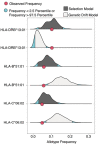Analysis of Genomic DNA from Medieval Plague Victims Suggests Long-Term Effect of Yersinia pestis on Human Immunity Genes
- PMID: 34002224
- PMCID: PMC8476174
- DOI: 10.1093/molbev/msab147
Analysis of Genomic DNA from Medieval Plague Victims Suggests Long-Term Effect of Yersinia pestis on Human Immunity Genes
Abstract
Pathogens and associated outbreaks of infectious disease exert selective pressure on human populations, and any changes in allele frequencies that result may be especially evident for genes involved in immunity. In this regard, the 1346-1353 Yersinia pestis-caused Black Death pandemic, with continued plague outbreaks spanning several hundred years, is one of the most devastating recorded in human history. To investigate the potential impact of Y. pestis on human immunity genes, we extracted DNA from 36 plague victims buried in a mass grave in Ellwangen, Germany in the 16th century. We targeted 488 immune-related genes, including HLA, using a novel in-solution hybridization capture approach. In comparison with 50 modern native inhabitants of Ellwangen, we find differences in allele frequencies for variants of the innate immunity proteins Ficolin-2 and NLRP14 at sites involved in determining specificity. We also observed that HLA-DRB1*13 is more than twice as frequent in the modern population, whereas HLA-B alleles encoding an isoleucine at position 80 (I-80+), HLA C*06:02 and HLA-DPB1 alleles encoding histidine at position 9 are half as frequent in the modern population. Simulations show that natural selection has likely driven these allele frequency changes. Thus, our data suggest that allele frequencies of HLA genes involved in innate and adaptive immunity responsible for extracellular and intracellular responses to pathogenic bacteria, such as Y. pestis, could have been affected by the historical epidemics that occurred in Europe.
Keywords: HLA; Yersinia pestis; aDNA; ancient DNA; human immunity; natural selection; plague.
© The Author(s) 2021. Published by Oxford University Press on behalf of the Society for Molecular Biology and Evolution.
Figures



References
-
- Abi-Rached L, Dorighi K, Norman PJ, Yawata M, Parham P.. 2007. Episodes of natural selection shaped the interactions of IgA-Fc with FcalphaRI and bacterial decoy proteins. J Immunol. 178(12):7943–7954. - PubMed
-
- Albright FS, Orlando P, Pavia AT, Jackson GG, Cannon Albright LA.. 2008. Evidence for a heritable predisposition to death due to influenza. J Infect Dis. 197(1):18–24. - PubMed
Publication types
MeSH terms
Substances
Grants and funding
LinkOut - more resources
Full Text Sources
Other Literature Sources
Medical
Research Materials

